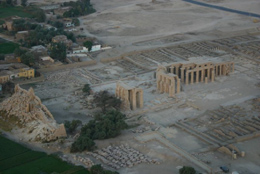
Aswan - danger to Egyptian temples
 |
Currently, there is an ambitious project aimed at lowering the groundwater level by two meters, which is undermining the foundations of some of the ancient buildings that are among the most visited by tourists in the world.
"The temples are in very serious condition, as they have suffered the worst damage in thousands of years of their existence over the last two decades," pointed out project leader Jeremy Gustaffon from the U.S. Agency for International Development (USAID).
The cause of this state lies 250 kilometers further south, at the Aswan dam. Since its completion in 1970, the groundwater level has risen significantly, becoming an immediate threat to the temple structures. Additionally, there is the filtration of water coming from the irrigation system of agricultural lands around the city, which has also increased in recent years.
"Given that the monuments are made of porous sandstone, they can absorb water, which has already happened at the foundations of the temples," emphasized Gustaffon. A similar project was used in Luxor on the other side of the Nile and helped save, for example, the magnificent temples at Karnak.
The new initiative will now focus primarily on the monumental Ramesseum (the mortuary temple of Ramses II), the temples of Seti I and Amenhotep III, and the temple complex of Medinet Habu, as well as smaller temple structures and tombs on the west bank of the Nile, announced Sabri Abdal Azíz, director of the Egyptology department of the Supreme Council of Antiquities. The implementation of the project, with a budget of around nine million dollars, will begin in June.
In a five-kilometer long area filled with ancient monuments, workers under the supervision of both American and Egyptian experts - technicians and archaeologists - will dig to a depth of seven meters to lower the groundwater level.
However, the entire plan will not only help dry out ancient Egyptian structures but will also allow archaeologists to discover what has so far been hidden by water. "We do not rule out at all that the excavations will bring new archaeological discoveries," noted Azíz.
For this reason, certain measures will be observed during the implementation of the project, such as the use of soil sensors that should detect any possible archaeological artifact even before digging begins. And if necessary, researchers are prepared to dig by hand. They will adhere to the principle that work must be at least 50 meters away from the temples.
Finally, pipes will be installed in the excavations to divert all groundwater to a nearby canal.
The project will last for 17 months, but it will not affect tourism - visitors will continue to be able to admire the Ramesseum, the temples of Seti I and Amenhotep III, and the complex at Medinet Habu, which lies south of the Valley of the Kings, without restriction.
The witnesses of the glory of the most powerful pharaohs of the ancient empire on the Nile, the Theban monuments, will be able to rest on more secure foundations. And along with them, the gods will be able to dream peacefully their eternal dream.
(CTK/EFE)
The English translation is powered by AI tool. Switch to Czech to view the original text source.
0 comments
add comment






